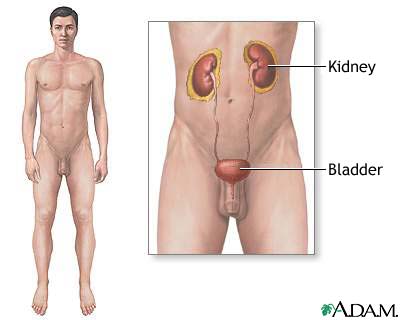Alternate Names : Kimmelstiel-Wilson disease, Diabetic glomerulosclerosis, Nephropathy – diabetic
Definition
Diabetic nephropathy is kidney disease or damage that results as a complication of diabetes.
See also:
- Type 1 diabetes
- Type 2 diabetes
- Risk factors for diabetes
- Chronic kidney disease
Overview, Causes, & Risk Factors
The exact cause of diabetic nephropathy is unknown, but it is believed that uncontrolled high blood sugar leads to the development of kidney damage, especially when high blood pressure is also present. In some cases, your genes or family history may also play a role. Not all persons with diabetes develop this condition.
Each kidney is made of hundreds of thousands of filtering units called nephrons. Each nephron has a cluster of tiny blood vessels called a glomerulus. Together these structures help remove waste from the body. Too much blood sugar can damage these structures, causing them to thicken and become scarred. Slowly, over time, more and more blood vessels are destroyed. The kidney structures begin to leak and protein (albumin) begins to pass into the urine.
Persons with diabetes who have the following risk factors are more likely to develop this condition:
- African American, Hispanic, or American Indian origin
- Family history of kidney disease or high blood pressure
- Poor control of blood pressure
- Poor control of blood sugars
- Type 1 diabetes before age 20
- Smoking
Diabetic nephropathy generally goes along with other diabetes complications including high blood pressure, retinopathy, and blood vessel changes.
Pictures & Images
Male urinary system
 The urinary system is made up of the kidneys, ureters, urethra and bladder.
The urinary system is made up of the kidneys, ureters, urethra and bladder.
Pancreas and kidneys

Uncontrolled diabetes causes damage to many tissues of the body including the kidneys. Kidney damage caused by diabetes most often involves thickening and hardening of the internal kidney structures. Strict blood glucose control may delay the progression of kidney disease in type 1 and type 2 diabetics.
Diabetic nephropathy

During diabetic nephropathy the kidney becomes damaged and more�protein than normal collects in the urine. As the disease progresses, more of the kidney is destroyed. Over time, the kidney’s ability to function starts to decline, which may eventually lead to chronic kidney failure.
-
Diabetic nephropathy : Overview, Causes, & Risk Factors
-
Diabetic nephropathy : Symptoms & Signs, Diagnosis & Tests
-
Diabetic nephropathy : Treatment



Review Date : 5/20/2009
Reviewed By : Reviewed by David Zieve, MD, MHA, Medical Director, A.D.A.M., Inc. Also reviewed by Deborah Wexler, MD, Assistant Professor of Medicine, Harvard Medical School, Endocrinologist, Massachusetts General Hospital.
The information provided herein should not be used during any medical emergency or for the diagnosis or treatment of any medical condition. A licensed medical professional should be consulted for diagnosis and treatment of any and all medical conditions. Call 911 for all medical emergencies. Links to other sites are provided for information only — they do not constitute endorsements of those other sites. © 1997- 2010 A.D.A.M., Inc. Any duplication or distribution of the information contained herein is strictly prohibited.
